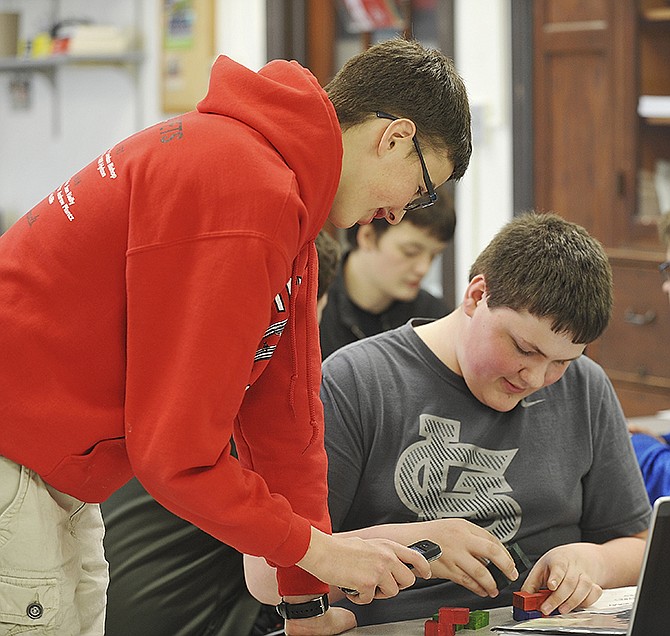With Project Lead the Way (PLW) courses, Jefferson City High School students are learning scientific concepts most professional engineers didn't encounter until they stepped onto a college campus.
Recently, Jefferson City Public Schools science and math teachers learned they have earned PLW national certification to teach courses such as "Introduction to Engineering Design" and "Principles of Engineering." Next year teachers plan to add "Civil Engineering and Architecture" to the school's curriculum, followed by the program's capstone course, "Engineering Design and Development," in 2016-17.
Karen Brickey, PLW and A+ program coordinator, said the No. 1 benefit students will derive from the national certification is the ability to earn college credit for courses they take while still in high school.
Kyle Craft, 17, is taking "Principles of Engineering" this year. The class is typically available to sophomores, but Craft, a junior, was able to enroll.
"I got in," he said. "I feel very fortunate."
Brickey said if Craft does well both in the class and on the end-of-course exam - which he's on track to do - he'll be eligible for credit from the Missouri University of Science and Technology in Rolla.
"Is it important for us, as educators?" Brickey asked. "Yes. But is it important for students? Definitely, because it highly benefits them."
To gain the national certification, Jefferson City teachers spent their summers in professional seminars, attended state and national conferences, partnered with local industry professionals and documented how they've promoted the program. Students were assessed on learning documented in their notebooks and portfolios.
Launched in upstate New York by a teacher who encouraged his students to study engineering, PLW has since grown into a national STEM-focused curriculum designed to prepare middle and high school students for the global economy. (STEM means it emphasizes science, technology, engineering and math.)
"One of the things Project Lead the Way stresses is bringing in industry partners into the classroom," Brickey noted.
David Straatmann, civil engineer with Jefferson City's Bartlett and West office, brought a scale model of a bridge to Craft's classroom to explain the different forces involved in a truss design.
"Some things need hands-on experience," Straatmann said.
Taught by math instructor Jana Forck, Craft and his peers have filled their self-assessment notebooks with hundreds of formulas, schematics and charts they gave learned and ideas they have tried and tested. Craft's is filled nearly cover to cover with his neat, tightly-packed handwriting.
In one unit students learned about simple machines, such as screws, levers, wedges, incline planes and pulleys. Another focused on civil engineering concepts. A third introduced students to nuclear and hydrogen power.
"It's the first truly vocational course I've taken," Craft said.
Forck said the courses are unique because they require students to work through the entire design process. They brainstorm ideas for problems they would like to solve, gather opinions, narrow ideas down to a potential solution and test it.
"They have free rein with solutions, but they are graded heavily on documentation of their thought processes and every change they made," she said.
Designing a faster model air boat with a hydrogen fuel cell was one project. Some used plastic bottles; others used molded Styrofoam. A few used the school's three-dimensional printer.
At Simonsen 9th Grade Center, where he is enrolled in the "Introduction to Engineering Design" course, Nathan Erickson, 15, created a 3D puzzle for his peers to solve.
Erickson and Craft both said no other courses in their respective schools afford them the same level of independence in their learning, or are as hands-on.
"My regret is they didn't offer it last year," Craft said. "I really enjoyed this class."
Although the engineering sequence is the first JCHS has been certified for, teachers have also developed courses for the bio-medical sequence and plan to do so for the computer science sequence.
The plan is to eventually be nationally-certified in all three sequences.
Middle schoolers already take the Gateway to Technology course, Brickey added, and Gov. Jay Nixon has been promoting launching PLW in elementary schools across the state.
Brickey said Jefferson City's teachers were delighted, on their first try, to get a "glowing report" from the national examiners. Improving the program's gender diversity is one goal they'd like JCHS to work on.
"We want to grow our program and make it the best in the state," she said.

